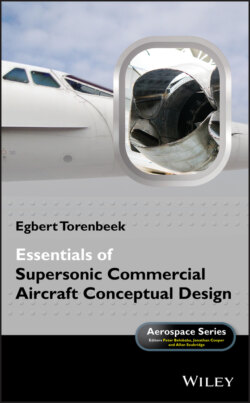Читать книгу Essentials of Supersonic Commercial Aircraft Conceptual Design - Egbert Torenbeek - Страница 17
1.6.1 Why Fly Supersonically?
ОглавлениеAlthough wide‐body seating during long‐distance flights of a long‐range subsonic airliner offers high spatial comfort, the high‐priced tickets of first class and business class seating do not compensate in the form of significantly reduced boarding and traveling times. The essential economic issue is the air traveler's value of time. Some SST economic studies base the value of time on the actual earning rate for business travel and on one half the earning rate for personal travel. Concorde's concept of flying at Mach 2.0 across the Atlantic was a technical success and high‐speed flying has remained attractive, especially to hasty officials.
Concordes were flagship aircraft flying at premium fares giving prestige to their passengers and operators. However, its substantial operating costs made high fares necessary: in the year 2000 the return ticket price London–New York was roughly 10,000 US dollars compared to 8,000 dollars for first class and 5,000 dollars for business class tickets of subsonic airliners. Nevertheless, Concorde's relatively high load factors and the fact that the ticket prices at the turn of the century were increasing by approximately 15% per year showed that a niche market existed for much faster passenger transport than any subsonic airliner can offer. It seems fair to assume that today a significant percentage of airline passengers is prepared to pay a premium fare, making this type of executive traveling commercially attractive to airlines. The unique achievements of the Concorde program justified sustained supersonic cruising from the technical viewpoint during its lifetime. Although technology has progressed steadily since Concorde was conceived, it was decades ahead of its time and nowadays we cannot do significantly better. Nevertheless, new technical innovations and organizational approaches will be mandatory to develop and operate a second generation SCT in the economic and regulatory environment of the 21st century.
Having surveyed the abundance of research achievements and project proposals generated during the half century after Concorde's first flight, one could anticipate that significantly improved concepts have become available in most aeronautical disciplines and production capabilities that could lead to a realistic program for development, production, and operation of an environmentally acceptable and economically viable second generation supersonic airliner. A crucial condition for such a program is that a new HSCT will be developed and produced by a consortium of R&D institutes and companies in America, Europe, and East‐Asia. Since all engineers involved in the first generation supersonic airliners are no longer available to apply their knowledge to such a development, considerable effort will be required to bring together and educate sufficiently experienced staff. The availability of relevant progress reports of previous projects will be indispensable to make such an international project team manageable and effective.
